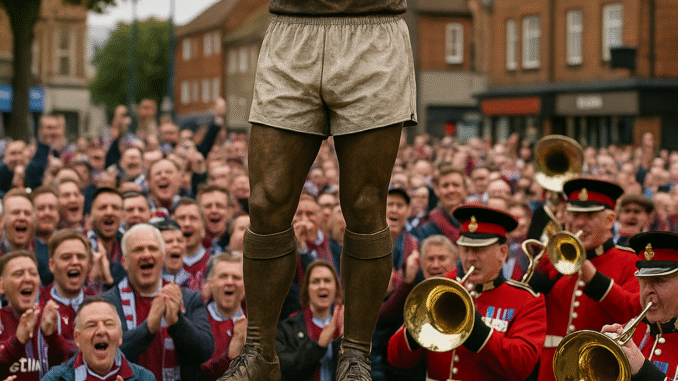
⚒️ West Ham United Legend Bobby Moore Honored with Statue in His Hometown
In a poignant and long-awaited tribute, Bobby Moore, the legendary West Ham United and England captain, has been honored with a statue in his hometown of Barking, East London. The unveiling ceremony, attended by former players, dignitaries, fans, and members of Moore’s family, marked a powerful moment of reflection and celebration for one of English football’s greatest icons.
Located in a prominent public square in Barking town centre, the bronze statue captures Moore in his iconic West Ham kit, arms calmly folded, exuding the calm authority and elegance that defined his career. The statue stands not just as a tribute to Moore’s legacy, but as a reminder of the deep bond between football, community, and history.
A Legacy Beyond Compare
Bobby Moore is a name that transcends club loyalties. Revered across England and admired globally, Moore captained the Three Lions to their only World Cup victory in 1966, becoming a national hero. At club level, he was West Ham through and through, making over 640 appearances between 1958 and 1974.
Regarded as one of the most intelligent and graceful defenders the game has ever seen, Moore’s leadership, composure, and sportsmanship set the gold standard for generations to come.
“He was the best defender I ever played against,” said Pelé, himself a legend. “I think of Bobby Moore as a real gentleman.”
While Wembley already hosts a towering statue of Moore alongside fellow England heroes, the Barking statue represents something different—a deeply personal, grassroots recognition of the man behind the legend.
A Community’s Tribute
The idea of honoring Moore in Barking had been in discussion for years, and it finally came to life thanks to a collaborative campaign led by local residents, the Barking and Dagenham Council, and West Ham United Football Club.
The statue project was made possible through public fundraising, a grant from the Football Foundation, and significant support from the Moore family. The final piece was sculpted by renowned artist Philip Jackson, whose previous works include statues of Queen Elizabeth II and Mahatma Gandhi.
Unveiled in a touching ceremony, the event included speeches from Mayor Darren Rodwell, West Ham chairman David Sullivan, and Moore’s daughter Roberta Moore, who said:
“My father loved this area. It shaped him into the man and footballer he became. To see him honored like this, right where his journey began, is something our family will cherish forever.”
A Day of Reflection and Celebration
Thousands gathered for the event, with a sea of claret and blue shirts in the crowd. Fans sang “Bubbles,” waved flags, and laid flowers at the base of the statue. The unveiling was followed by a football festival held in nearby Central Park, where local youth teams took part in friendly matches—fitting, as Moore himself began playing football on these very streets.
West Ham legends including Sir Trevor Brooking, Martin Peters’ family, and Tony Cottee were also in attendance, sharing memories of Moore and reflecting on his legacy.
Sir Trevor Brooking called the tribute “long overdue,” adding:
“He made the extraordinary look effortless. And off the pitch, he was humble and approachable—this statue captures both the man and the myth.”
West Ham’s Continuing Commitment
West Ham United, who have already immortalized Moore with a stand named after him at the London Stadium, reiterated their commitment to honoring club legends and investing in the East London community.
In his address, co-owner David Gold said:
“Bobby Moore remains the heartbeat of this club. This statue in Barking, where he took his first steps into football, is a fitting symbol of where greatness begins—with family, community, and grassroots passion.”
The club also announced plans for a community outreach program named the Bobby Moore Football Foundation, designed to provide free coaching, educational support, and health awareness in local schools across East London.
Why This Matters Now
The timing of the tribute couldn’t be more relevant. In an age where the sport continues to grow in commercial scale and global reach, Moore’s story is a reminder of football’s soul—the power of local heroes to inspire national dreams.
Born and raised in a modest home, Bobby Moore showed that greatness doesn’t come from flash or hype, but from discipline, humility, and love of the game. This new statue roots his story firmly in the streets that shaped him, offering a visible, permanent reminder for future generations.
Final Thoughts
Statues are more than just metal and stone—they’re symbols of memory, values, and collective identity. For Barking, and for West Ham supporters everywhere, the new Bobby Moore statue is a moment of closure, pride, and enduring connection.
As the sun set on the ceremony and children kicked footballs in the park nearby, one thing was clear: the legacy of Bobby Moore isn’t fading—it’s being passed on, in the very place where it all began. ⚒️
Leave a Reply